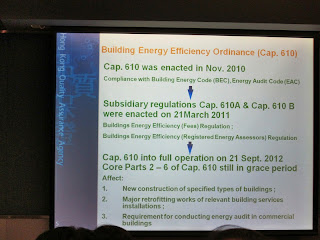The first speaker was Mr. Thomas Ma (Senior Auditor, HKQAA) and his presentation entitled "Introduction to the ISO 50001 Energy Management System (EnMS) Standard".
In the beginning, Mr. Thomas Ma explained why we went for Energy Management because of environment degradation and higher fuel/energy prices. Then he briefed the schedule of Building Energy Efficiency Ordinance (Cap. 610).
Mr. Ma said "Energy Management is to enhance energy performance (energy efficiency, use and consumption) by meeting Legal and Other Requirements, and Continual Improvement in a systematic approach." He demonstrated the data about energy performance in Hong Kong compared with other countries. Energy Performance included Energy Use, Energy Intensity, Energy Consumption and Energy Efficiency, etc.
PDCA Approach was employed and Energy Planning Process was introduced step by step.
The second speaker was Ir. Dr. Mckey Ho (Manager, Quality Management, Housing Department, HKSAR Government) and his presentation topic was "Sharing of ISO 50001 Energy Management Certification Journey".
Firstly, Dr. Ho explained the terms "Energy in Use" and "Embodied Energy". "Energy in Use" was "Energy used once the building is occupied". "Embodied Energy" meaned "Energy used to extract & process the raw materials, in transporting materials & components to site, and during construction."
Then Dr. Ho discussed the boundary of ISO 50001 certification. He said the scope was aligned with ISO 9001 and ISO 14001, but he added a remark for contract administration in which referred to the contract addministration processes for ensuring that all installed energy systems, products and the associated testing and commissioning were in compliance with the contract requirements. After that he introduced their energy planning process.
The first step was to analyze Energy Use & Consumption. Lighting was identified as "Significant Energy Use". And then energy baseline was established after data collection and estimation. Therefore, a single parameter in "kWh" obtained from the summation of energy use in communal area of domestic building block and normalized relative to the communal floor area is used as the Energy Performance Indicator (EnPI). One of indicator named "Annual Total Energy Consumption per Area (kWh/m2/Annum)".
Finally, Dr. Ho concluded the three methods for improving energy performance below.
1) Use of energy efficiency products
2) Administrative procedures
3) Optimize the energy source
The third speaker was Mr. Osman Lau (Engineer, Energy Efficiency, EMSD, HKSAR Government) and his presentation named "Briefing on the Buildings Energy Efficiency Ordinance (Cap. 610)".
Mr. Lau briefed the milestone of the Buildings Energy Efficiency Ordinance (BEEO) and it would come into full operation on 21 Sep 2012. There were two codes under BEEO, Cap 610. They were Energy Audit Code (EAC) and Building Energy Code (BEC).
The coverage of BEEO for prescribed building was mentioned. Some exception building was outlined.
Major retrofitting works for units or common areas in both newly constructed and existing buildings prescribed in the BEEO.
After that Mr. Lau shared six key steps of energy audit
1) Collection of information of the building
2) Review of energy consuming equipment / systems
3) Identification of Energy Management Opportunity (EMO)
4) Cost benefit analysis of EMO
5) Recommendations
6) Compiling energy audit report / Energy Audit Form
Lastly, Mr. Lau explained the qualification of Registered Energy Assessors (REA) such as RPE or MHKIE in electrical, mechanical, building services or environmental discipline.
Q&A Session
During Q&A session, Mr. Lau said all contractors in HA list needed to achieve ISO 50001 on 31 Dec 2012 with a grey period.
Reference:
HKQAA - http://www.hkqaa.org














沒有留言:
發佈留言